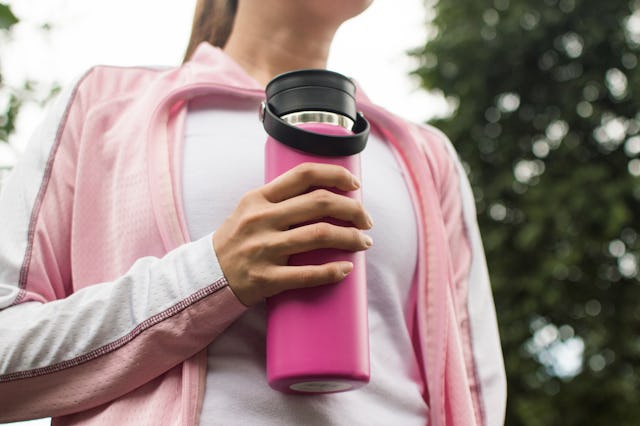Your Reusable Water Bottle May Carry More Bacteria Than A Toilet Seat, Study Finds
And not just a little more... a lot more.

Reusable water bottles are as trendy as ever. And that’s great! A sturdy, reliable, and reusable water bottle is a wonderful way to stay hydrated and help the environment by cutting down on plastic water bottles. If you’re like me, my “emotional support” water bottle goes with me everywhere, and it’s basically never empty. So, I find myself washing it pretty rarely. It’s just water, right? How gross could it get?
Well, according to a new study conducted by U.S.-based site waterfilterguru.com, a reusable water bottle can get pretty freaking disgusting. The study revealed that reusable water bottles can carry up to 40,000 times more bacteria than the average toilet seat.
Let that sink in for a moment.
Researchers swabbed the spout lid, straw lid, and squeeze-top lid parts of different water bottles three times each. The results showed gram-negative rods and bacillus bacteria present throughout the swabs. According to researchers, gram-negative bacteria can cause infections resistant to antibiotics, and certain types of bacillus bacteria can cause gastrointestinal issues.
The study found that spout-top and screw-top lids contained the most bacteria of all the water bottles, with 30 million CFUs (colony-forming units) each.
Researchers also swabbed multiple frequently-used household items, including toilets, dog bowls, computer mice, and kitchen sinks. So, how did these germ-collecting items stack up against a reusable water bottle? It wasn’t even close.
As we now know, reusable water bottles can carry up to 40,000 times more bacteria than the average toilet seat. They also revealed 14 times as much bacteria as a dog’s water bowl and twice as much as a standard kitchen sink.
Researchers urged reusable water bottle users to wash their water bottles every single day to avoid bacteria growth. It seems like this needs to be reiterated since a survey of 1,000 Americans showed that only 42% said they washed their reusable bottles daily.
One-quarter of Americans surveyed wash their water bottles just a few times per week, while over 10% only clean them a few times per month. The survey also found that Gen Z cleaned their bottles the least often, with 16% cleaning theirs only a few times monthly.
Turns out, it doesn’t really matter that it’s “just water” hanging out in your cup; it can still get absolutely gross.
Microbiologist Miryam Z. Wahrman told Reader’s Digest that germs and microbes — including bacteria, viruses, and fungi — thrive in moist, warm environments like water bottles. “Contaminated water bottles can transmit pretty much anything you can catch from casual contact with another person,” says Wahrman.
“That’s not to say that every germ you encounter will make you sick, because we have immunity and other barriers to germs, like our stomach acid, for instance, that kill microbes. But being exposed needlessly to unknown microbes could increase your risk of disease.”
If you’re stumped about how to properly wash and sanitize a reusable water bottle, the steps are pretty simple.
“You’ll want to use soap and hot water to get rid of germs,” Good Housekeeping Institute’s Carolyn E. Forté tells HuffPost. “And pay special attention to the nooks and crannies in the cap. Germs have been found in these caps even after washing if they aren’t washed thoroughly enough.”
Read the entire eye-opening study here.